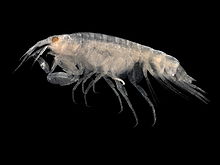
Amphipoda is an order of malacostracan crustaceans with no carapace and generally with laterally compressed bodies. Amphipods range in size from 1 to 340 millimetres and are mostly detritivores or scavengers. There are more than 9,900 amphipod species so far described. They are mostly marine animals, but are found in almost all aquatic environments. Some 1,900 species live in fresh water, and the order also includes the terrestrial sandhoppers such as Talitrus saltator and Arcitalitrus sylvaticus.

The monarchs comprise a family of over 100 passerine birds which includes shrikebills, paradise flycatchers, and magpie-larks.
In mycology, the terms teleomorph, anamorph, and holomorph apply to portions of the life cycles of fungi in the phyla Ascomycota and Basidiomycota:

The Reverend Thomas Roscoe Rede Stebbing was a British zoologist, who described himself as "a serf to natural history, principally employed about Crustacea". Educated in London and Oxford, he only took to natural history in his thirties, having worked as a teacher until then. Although an ordained Anglican priest, Stebbing promoted Darwinism in a number of popular works, and was banned from preaching as a result. His scientific works mostly concerned crustaceans, especially the Amphipoda and Isopoda, the most notable being his work on the amphipods of the Challenger expedition.

Gammaridea is one of the suborders of the order Amphipoda, comprising small, shrimp-like crustaceans. Until recently, in a traditional classification, it encompassed about 7,275 (92%) of the 7,900 species of amphipods described by then, in approximately 1,000 genera, divided among around 125 families. That concept of Gammaridea included almost all freshwater amphipods, while most of the members still were marine.
Ochlesidae is a family of amphipods. They are very small, often less than 1.5 millimetres (0.06 in) long, and are found mainly in tropical and subtropical areas of the Southern Hemisphere. The family Odiidae has sometimes been subsumed into Ochlesidae.

Platyischnopidae is a family of amphipod crustaceans. Its members are characterised by the conical rostrum, which is covered with sensory pits at the end. Although digging behaviour has only been directly observed in a few taxa, it is assumed that all the animals in the family Platyischnopidae are fossorial. The genera included in Platyischnopidae are Skaptopus, Platyischnopus, Indischnopus, Tiburonella, Eudevenopus, Tittakunara, Tomituka and Yurrokus.
Phliantidae is a family of isopod-like amphipod crustaceans chiefly from the southern hemisphere.

Cumacea is an order of small marine crustaceans of the superorder Peracarida, occasionally called hooded shrimp or comma shrimp. Their unique appearance and uniform body plan makes them easy to distinguish from other crustaceans. They live in soft-bottoms such as mud and sand, mostly in the marine environment. There are more than 1,500 species of cumaceans formally described. The species diversity of Cumacea increases with depth.
Chiltonia is a genus of amphipod crustaceans endemic to New Zealand. Four species are known, three of which live in fresh waters. They were first discovered by Charles Chilton in 1898 and the genus Chiltonia was erected the following year by T. R. R. Stebbing in Chilton's honour.

Leucothoe is a genus of amphipods in the family Leucothoidae. It contains the following species:

Gammaridae is a family of amphipods. In North America they are included among the folk taxonomic category of "scuds", and otherwise gammarids is usually used as a common name.

The grey goshawk is a strongly built, medium-sized bird of prey in the family Accipitridae that is found in eastern and northern Australia. The white morph of this species is known as the white goshawk.

Cyproideidae is a family of amphipod crustaceans. Eighteen genera and 43 species have been described as of 2009. They mostly occur mostly in the Southern Hemisphere, where they form associations with corals, sponges, crinoids and hydroids.

Iphimedia is a genus of amphipods which belongs to the family Iphimediidae in the arthropod group Amphipoda. It is the only genus of the family to have species which live in tropical waters. All other genera of the family are only found in cold or deep oceans.
Babr is a genus of amphipod crustaceans in the family Pallaseidae, endemic to Lake Baikal. There are 2 species in the genus.

Amphilochus is a genus of crustaceans in the Amphipoda order, containing the following species:
Paramoera walkeri is an amphipod of the genus Paramoera. It lives around Antarctica.

Parawaldeckia is a genus of amphipod crustacean in the family, Lysianassidae. and was first described by Thomas Roscoe Rede Stebbing in 1910. The type species is Parawaldeckia thomsoni.

Bellorchestia marmorata is a marine amphipod in the Talitridae family.












